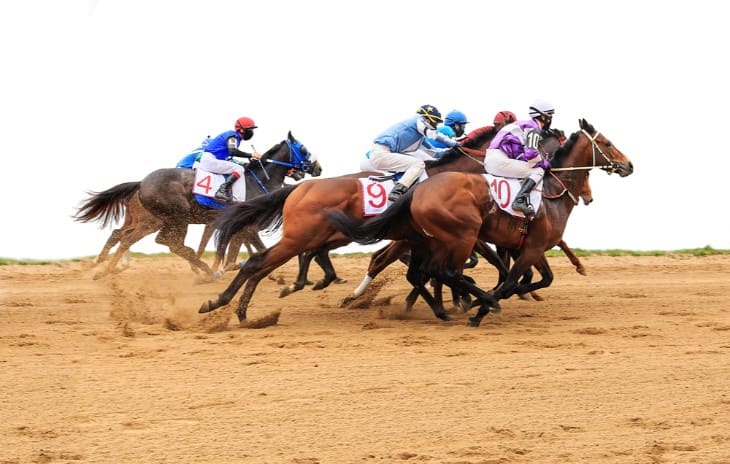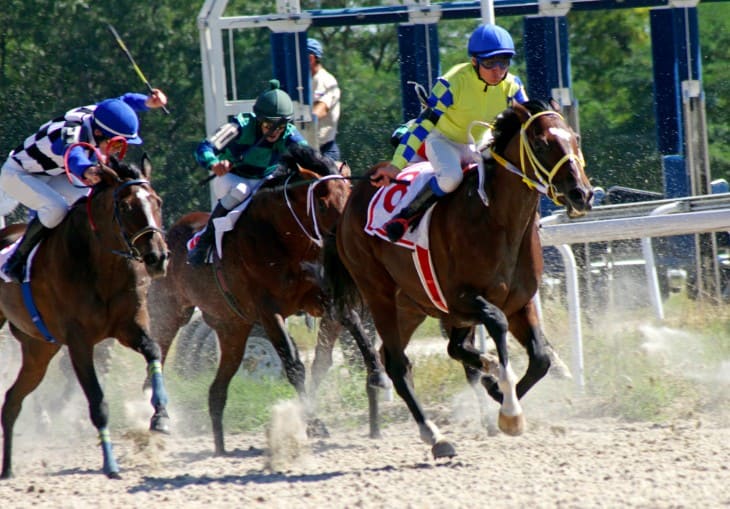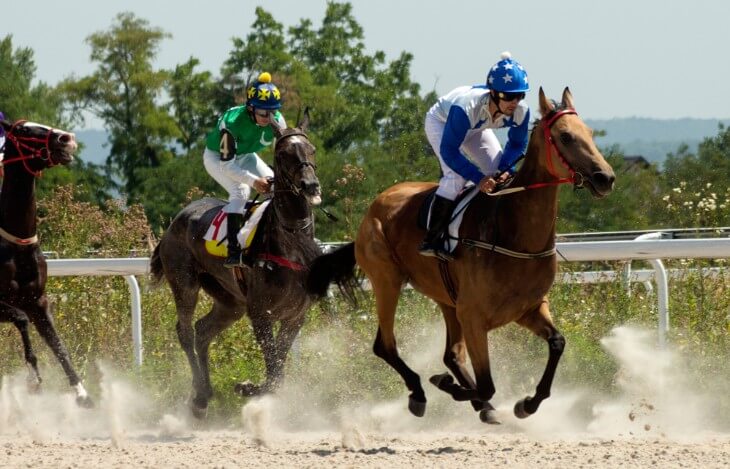The world of horse racing is a realm steeped in traditions and superstitions that weave a rich tapestry of beliefs and practices. From lucky colours and numbers to the mystique of horseshoes, these elements carry cultural significance that transcends the race track. Horse racing enthusiasts often engage in pre-race rituals, channelling psychological comfort and focus, while the enigmatic act of touching wood persists as a gesture to ward off misfortune. Rain on Derby Day, either seen as a cleansing symbol or a potential challenge, underscores the emotional and transformative impact of the natural world on the sport.
These customs, rooted in centuries of belief and experience, reflect the human longing for control and connection in the exhilarating realm of horse racing. Let’s a more detailed look at them:
Royal Ascot
Royal Ascot is an iconic event in the United Kingdom's horse racing calendar, renowned for its elegance, glamour, and royal presence. Held annually in the month of June, this five-day spectacle takes place at Ascot Racecourse, situated in the picturesque Berkshire countryside. The event is not only a celebration of exceptional horse racing but also a showcase of British high society and fashion.
Fashion and Etiquette: Dressing to Impress
One of the distinctive aspects of Royal Ascot is its strict dress code. Each day of the event has a designated dress code, ranging from formal to more relaxed attire. Attendees are expected to adhere to these guidelines, which often include specific requirements for hats, dresses, suits, and ties. The Royal Enclosure, where members of the royal family can be spotted, has the most stringent dress code, demanding top hats and morning suits for men, and elegant dresses with a modest hemline and headpieces for women.
The Royal Procession: A Grand Arrival
Each day at Royal Ascot begins with the Royal Procession, a ceremonial arrival of the Queen and other members of the royal family in horse-drawn carriages. This tradition marks the start of the day's racing events and is met with much anticipation from the crowd.
World-Class Racing: A Showcase of Equine Excellence
While the fashion and royal presence are key elements of Royal Ascot, the heart of the event is, of course, the horse racing. The race card features a variety of races, from sprints to longer-distance contests, showcasing the skills of both horses and jockeys. The most prestigious race of the event is the Gold Cup, a gruelling long-distance race that tests the stamina and determination of the competing horses.
Gourmet Dining and Fine Refreshments
Royal Ascot offers a range of dining options that cater to diverse tastes. From champagne bars to fine dining restaurants, attendees can indulge in delectable cuisine and refreshments while enjoying the excitement of the races. The picnic area also allows racegoers to bring their own food and enjoy a more relaxed dining experience.
Ladies Day: A Celebration of Elegance
Ladies' Day, traditionally held on the Thursday of Royal Ascot, is a highlight of the event. This is the day when attendees showcase their most stylish and creative outfits, often accompanied by elaborate and eye-catching hats or fascinators. A fashion competition, the "Style Awards," adds an extra layer of excitement to Ladies' Day, with prizes awarded to the most fashionable attendees.
A Time-Honored Tradition
With a history dating back to the early 18th century, Royal Ascot is a truly time-honoured tradition that embodies the essence of British heritage, elegance, and sporting excellence. It continues to attract racing enthusiasts, fashion aficionados, and socialites from around the world, making it an unforgettable experience that marries sport, fashion, and regal splendour in a uniquely British manner.
Grand National
The Grand National is a renowned and cherished event in the United Kingdom's horse racing calendar. Held annually at Aintree Racecourse near Liverpool, the Grand National is a steeplechase like no other, capturing the hearts and attention of people across the nation.
A Challenging Course: Iconic Fences and Unique Challenges
One of the most distinctive aspects of the Grand National is its uniquely challenging course. The track spans about 4 miles and 514 yards (approximately 6.9 kilometres) and features 30 formidable fences, including some legendary obstacles like "Becher's Brook" and "The Chair." These fences are known for their size, variety, and the demanding nature of the jumps, making the Grand National one of the most testing races in the world.
National Hunt Racing: A Test of Stamina and Courage
The Grand National is a National Hunt race, which means it involves jumping over obstacles like fences and ditches. This type of racing places a strong emphasis on the horse's jumping ability, stamina, and the jockey's skill in navigating the course.
Aintree's Electric Atmosphere: Roars from the Crowd
The atmosphere at Aintree during the Grand National is electric. Tens of thousands of spectators gather to witness the action, creating an unrivalled sense of excitement and anticipation. The race's challenging nature and unpredictable outcomes contribute to the nail-biting tension that builds as the horses and jockeys tackle the course.
Famous Winners and Memorable Moments
The Grand National has seen its fair share of legendary winners and unforgettable moments. Horses like Red Rum, who won the race three times in the 1970s, have become synonymous with the event. Red Rum's incredible feats and come-from-behind victories have solidified his place in racing history and endeared him to the public.
A Global Audience: Worldwide Viewership
The Grand National's popularity extends far beyond the UK's borders. It's estimated that hundreds of millions of people from around the world tune in to watch the race, making it one of the most-watched sporting events globally. The race's intrigue, drama, and the element of unpredictability contribute to its universal appeal.
A True British Tradition
The Grand National is more than just a horse race; it's a cherished British tradition that captures the essence of sporting prowess, courage, and determination. It brings together racing enthusiasts, casual viewers, and those seeking to experience the thrill of this unique equestrian spectacle. With its challenging course, storied history, and ability to capture the imagination, the Grand National continues to hold a special place in the hearts of people across the UK and beyond.
Cheltenham Festival
The Cheltenham Festival is a highlight in the British horse racing calendar, showcasing top-class National Hunt racing at its finest. Held annually at Cheltenham Racecourse in Gloucestershire, this four-day event is a celebration of skill, athleticism, and excitement that captivates racing enthusiasts and the wider public alike.

Prestigious Races and Iconic Moments
The festival is renowned for its prestigious races, each with its own unique challenges and character. Races like the Champion Hurdle, the Queen Mother Champion Chase, the Stayers' Hurdle, and the Cheltenham Gold Cup attract the best horses, jockeys, and trainers from across the UK and Ireland. The festival has seen legendary horses and jockeys etch their names into racing history with remarkable victories and unforgettable performances.
Cheltenham's Famous Course and Challenging Terrain
Cheltenham Racecourse boasts a challenging track that demands both speed and stamina. The undulating course features stiff uphill sections and downhill stretches, as well as challenging fences and hurdles. The track's distinct characteristics contribute to the thrilling nature of the racing, where strategy and adaptability are key.
Festival Atmosphere and Traditions
The atmosphere at Cheltenham Festival is truly electric. The stands are filled with enthusiastic racegoers who come to witness the spectacle and soak in the unique ambience. The roar of the crowd as the horses thunder down the final stretch is a signature sound of the festival.
The "Cheltenham Roar" refers to the deafening noise that erupts from the crowd as the tape goes up for the first race of the festival. This collective expression of excitement and anticipation set the tone for the days ahead.
St. Patrick's Thursday: A Celebration of Irish Influence
St. Patrick's Thursday, the third day of the festival, has a distinctive Irish flavour. It's a day when many Irish racegoers make the journey to Cheltenham, adding to the festive atmosphere. The hospitality and camaraderie among Irish attendees make it a day of celebration and unity.
Singing of "Auld Lang Syne" at Newbury
The tradition of singing "Auld Lang Syne" at Newbury Racecourse is a heartwarming and symbolic tradition that marks the beginning of a new racing season. This unique practice reflects the strong connections between horse racing and the sense of camaraderie and community among racegoers. Here's more about this tradition:
Newbury Racecourse and the Tradition:
Newbury Racecourse, located in Berkshire, England, is a prominent horse racing venue known for its rich history and picturesque setting. The tradition of singing "Auld Lang Syne" at Newbury has become a significant part of the racecourse's opening day festivities.
Welcoming the New Racing Season:
The singing of "Auld Lang Syne" at Newbury Racecourse is a way of welcoming the new horse racing season with a sense of unity and nostalgia. "Auld Lang Syne" is a traditional Scottish folk song that is often sung to bid farewell to the old year and welcome the new one. In the context of Newbury Racecourse, it symbolizes a fresh start and the anticipation of exciting racing events in the upcoming season.
Gathering of Racegoers:
On the opening day of the racing season at Newbury, racegoers gather in a communal area to participate in the singing of "Auld Lang Syne." This communal gathering creates a sense of shared enthusiasm and camaraderie among attendees, setting a positive tone for the rest of the season.
Cultural Significance:
While "Auld Lang Syne" has its origins in Scotland and is often associated with New Year's Eve celebrations, its use at Newbury Racecourse adds a unique and cultural touch to the opening of the racing season. The song's lyrics, which reflect on the passage of time and the value of old friendships, resonate with the themes of continuity and tradition that are integral to horse racing.
A Symbol of Unity:
The tradition of singing "Auld Lang Syne" at Newbury Racecourse underscores the interconnectedness of the horse racing community. It's a moment when racegoers, jockeys, trainers, and all those involved in the sport come together to celebrate their shared passion and the excitement of a new racing season.
Punters' Enclosure
The Punters' Enclosure is a designated area at a racecourse where spectators and punters gather to observe the horses before a race. It serves as a space for racegoers to assess the physical condition and behaviour of the horses before placing their bets. The Punters' Enclosure is an important feature of a racecourse, providing valuable insights for those who want to make informed betting decisions.
Key Aspects of the Punters' Enclosure:
- Horse Parading: One of the main purposes of the Punters' Enclosure is to allow spectators to see the horses up close as they parade before a race. This gives punters the opportunity to assess the horses' appearance, fitness, and demeanour before making their betting choices.
- Trainer and Jockey Interaction: In the Punters' Enclosure, spectators may have the chance to see the trainers and jockeys of the competing horses up close. This can provide additional insights into the confidence and approach of the trainers and jockeys, which can influence betting decisions.
- Physical Assessment: Punters often look for signs of a horse's health and readiness to compete. They may observe factors such as the horse's coat condition, muscle tone, and overall demeanour. These visual cues can help them gauge the horse's level of preparedness for the race.
- Behavioural Observations: How a horse behaves in the Punters' Enclosure can offer clues about its temperament and readiness. Calm and focused behaviour might suggest a horse is well-prepared, while signs of nervousness or agitation could indicate stress or unease.
- Informed Betting: The insights gained from observing the horses in the Punters' Enclosure can influence betting decisions. Punters may choose to back horses that appear fit, healthy, and well-prepared, based on their visual assessment.
- Interaction and Excitement: The Punters' Enclosure also serves as a social space where racegoers can engage with fellow punters, discuss their observations, and share insights. This interaction adds to the overall excitement and atmosphere of a race day.
- Accessibility: The Punters' Enclosure is usually accessible to all racegoers with general admission tickets. It provides an opportunity for a wide range of attendees, from experienced gamblers to casual race fans, to participate in the betting process.
Lucky Colors and Numbers
Lucky colours and numbers are elements of superstition that hold special significance to many people in various cultures, including in the context of horse racing. In the UK and other parts of the world, these superstitions are often observed by individuals involved in horse racing, such as jockeys, trainers, and even punters.
Lucky Colors:
- Red: Red is often associated with energy, power, and good luck. Some people believe that using red as part of racing silks, saddle cloths, or other racing-related items can bring luck to the horse and its connections.
- Green: Green is commonly associated with growth, renewal, and luck. It's considered a colour of positivity, and some believe that incorporating green into racing attire or decorations can attract good fortune.
- Blue: Blue is often linked to calmness, stability, and success. Many consider blue to be a lucky colour that can provide a sense of tranquillity and focus, which can be advantageous in a high-stakes environment like horse racing.
- White: White is associated with purity and clarity. In horse racing, a clean and well-prepared appearance is crucial, so the colour white can be seen as lucky when it represents the horse's health and condition.
- Gold/Yellow: Gold and yellow symbolize prosperity and happiness. Using these colours can be a way of attracting positive energy and success to the horse and its connections.

Lucky Numbers:
- 7 : The number 7 is often considered lucky in many cultures around the world. It's associated with good fortune and positive outcomes. Horses with the number 7 can sometimes be favoured by those who believe in the luck associated with this number.
- 8 : In some cultures, the number 8 is seen as highly lucky due to its resemblance to the infinity symbol. It's associated with prosperity and abundance, making it a sought-after number by some individuals.
- 3 : The number 3 is often linked to harmony, balance, and positive outcomes. Some believe that horses with the number 3 are more likely to have a successful race.
- Avoiding Unlucky Numbers: Just as lucky numbers are sought after, there are also numbers that are considered unlucky. For example, the number 13 is often avoided due to its association with bad luck in many cultures.
Touching Wood
"Touching wood," also known as "knocking on wood," is a common superstition observed in many cultures. The practice involves physically touching or tapping on a piece of wood, often accompanied by a phrase like "touch wood" or "knock on wood." The purpose of this action is to ward off bad luck, prevent jinxing a positive situation, or ensure the continuation of good fortune.
In the context of horse racing and other areas of life, touching wood is often done when someone mentions a positive outcome or expresses hope for the future. By touching or knocking on wood immediately afterwards, the person is believed to be protecting themselves from the potential negative consequences of talking about good things, which might otherwise attract bad luck.
For example, in horse racing, a jockey, trainer, or punter might touch wood after mentioning that a particular horse has been performing well in training or that the weather looks favourable for race day. It's a way of acknowledging the positive situation while simultaneously taking precautions against tempting fate.
The origins of the "touching wood" superstition are not entirely clear, but it likely dates back centuries to ancient beliefs in spirits, luck, and the power of natural elements. Wood, as a material from the natural world, was often associated with protective and mystical properties. Over time, this belief evolved into a common gesture that persists in modern times.
It's important to note that touching wood is not based on any empirical evidence or scientific rationale. Instead, it's a cultural superstition that reflects the human desire to exert control over uncertain outcomes and seek reassurance in the face of the unknown. Whether or not someone believes in the effectiveness of touching wood, it remains a lighthearted and widely recognized practice that adds an element of tradition and charm to various situations, including the world of horse racing.
Horseshoe Superstition
The horseshoe superstition is a widespread belief that horseshoes have the power to bring good luck and protect against evil spirits or bad fortune. This belief has ancient origins and has been a part of various cultures around the world for centuries. In the context of horse racing and equestrian activities, the horseshoe superstition is often associated with ensuring the well-being and success of horses and riders. Here's a bit more about the horseshoe superstition:
- Symbolism of Horseshoes: Horseshoes, being made of metal, were considered to possess special properties that could ward off malevolent spirits and bring positive energy. Their crescent shape was believed to capture and hold luck, with the open end facing upward to "hold" the luck in place.
- Placing Horseshoes: One common practice in the horseshoe superstition is to hang a horseshoe with the open end facing upward above a doorway or entrance. This is believed to ensure that anyone passing through the doorway would receive a dose of good luck.
- Protection for Horses: In the context of horse racing and equine activities, horseshoes were often placed in horse stalls or barns to protect the horses from harm and attract positive influences. Horseshoes were thought to provide a protective barrier against illness or injury.
- Direction Matters: The direction in which the horseshoe is hung is significant in some versions of the superstition. Hanging the horseshoe with the open end facing upward is believed to capture and retain good luck while hanging it with the open end facing downward is said to release the luck onto those passing beneath it.
- Metal Choice: The type of metal from which the horseshoe is made can also hold meaning. Iron horseshoes were considered particularly effective in dispelling negative energy and attracting luck.
- Carry a Horseshoe: Some individuals, including jockeys or equestrians, might carry a small horseshoe as a charm or talisman. This portable symbol of luck is believed to accompany them in races or other situations, enhancing their chances of success.
- Modern Adaptations: While the horseshoe superstition has ancient roots, it continues to be embraced in modern times, often in a lighthearted and decorative manner. Horseshoe motifs are commonly found in home decor, fashion accessories, and even lucky charms.
Pre-Race Rituals
Pre-race rituals are routines, actions, or behaviours that individuals, particularly athletes and competitors, engage in before a race or competition. These rituals are often rooted in personal beliefs, superstitions, or psychological strategies that help individuals prepare mentally and emotionally for the upcoming challenge. In the context of horse racing, both jockeys and trainers may have their own pre-race rituals that they believe bring them luck, focus, and confidence.
- Psychological Comfort: Pre-race rituals provide a sense of familiarity and psychological comfort. Engaging in specific actions or routines can help reduce anxiety and nerves, creating a sense of control in a high-stakes situation.
- Visualization and Focus: Many pre-race rituals involve visualization techniques. Athletes might mentally rehearse the race, imagining themselves succeeding and visualizing a positive outcome. This can enhance focus and confidence.
- Physical Preparation: Rituals might involve physical warm-up routines, stretching exercises, or light jogging to get the body primed for action. These activities help increase blood flow and prepare muscles for the demands of the race.
- Lucky Clothing: Wearing a specific item of clothing, such as lucky socks or a particular jersey, is a common pre-race ritual. The belief in the clothing's lucky properties can boost confidence and provide a mental edge.
- Listening to Music: Some individuals have a playlist of songs that they listen to before a race. Music can help regulate emotions, energize the individual, and create a focused mindset.
- Quiet Time: Taking a few moments of solitude or meditation before a race can help clear the mind and reduce distractions. This practice fosters relaxation and mental clarity.
- Team Huddles: In horse racing, trainers and jockeys often work closely with their teams. Pre-race huddles or discussions can help coordinate strategies, share insights, and boost morale among team members.
- Familiarization: Walking the track or reviewing the course map can be part of pre-race rituals. Familiarizing oneself with the environment and terrain can build confidence in navigation.
- Deep Breathing: Engaging in deep breathing exercises before a race can help lower stress levels, regulate heart rate, and increase oxygen intake for improved focus and performance.
- Superstitious Behaviors: Some pre-race rituals are rooted in superstition, such as touching wood, wearing a specific piece of jewellery, or following certain routines in a specific order.
- Positive Affirmations: Repeating positive affirmations or mantras can boost self-confidence and create a positive mindset before a race.
Rain on Derby Day
Rain on Derby Day, a superstition often associated with the Kentucky Derby in the United States, is believed to be a good omen by some and a potential source of worry for others. This superstition holds that rain on the day of the Derby can influence the outcome of the race and even bring luck to the participants.
- Cleansing Symbolism: Rain is often associated with renewal, cleansing, and a fresh start. Some people view rain on Derby Day as a symbolic cleansing of negative energies or bad luck, making way for positive outcomes and new beginnings.
- Luck and Freshness: Rain is perceived as a natural purifier that can wash away any negative influences. It's believed that the rain's freshness can have a positive impact on the race, giving jockeys and horses a renewed energy and focus.
- Luck for Mudders: In horse racing, some horses are particularly skilled at running on wet, muddy tracks. These horses are often referred to as "mudders." For trainers and owners of mudders, rain on Derby Day can be seen as a stroke of luck, as it levels the playing field by introducing conditions in that their horses excel.
- Symbol of Transformation: Rainfall can be seen as a transformative element, with the potential to change the track conditions dramatically. Some believe that the change in conditions can lead to unexpected outcomes, adding an element of excitement and unpredictability to the race.
- Concerns for Dry Tracks: On the flip side, there are those who prefer dry track conditions for the Derby. Dry tracks can favour certain types of horses and strategies. Rain can make the track slippery and affect the traction, potentially leading to altered race dynamics.
- Emotional Impact: Rainfall can have an emotional impact on both participants and spectators. It can add drama, tension, and a sense of urgency to the event, enhancing the overall experience of Derby Day.
- Personal Interpretation: As with many superstitions, the belief in the luck or significance of rain on Derby Day is a matter of personal interpretation. Some people wholeheartedly embrace the idea, while others might see it as nothing more than a charming tradition.
For more information:








